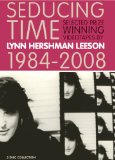| Reviews & Columns |
|
Reviews DVD TV on DVD Blu-ray 4K UHD International DVDs In Theaters Reviews by Studio Video Games Features Collector Series DVDs Easter Egg Database Interviews DVD Talk Radio Feature Articles Columns Anime Talk DVD Savant Horror DVDs The M.O.D. Squad Art House HD Talk Silent DVD
|
DVD Talk Forum |
|
|
| Resources |
|
DVD Price Search Customer Service #'s RCE Info Links |
|
Columns
|
|
|
Seducing Time By Lynn Hershman Leeson
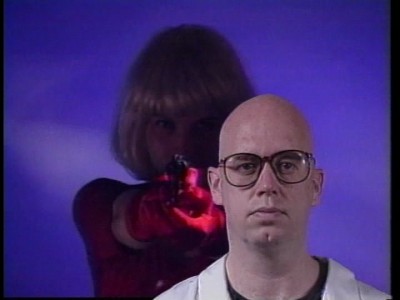
Watching the five video artworks collected on Seducing Time: Award-Winning Videos by Lynn Hershman Leeson, it is difficult not to free-associate to the tittering David Thewlis character, introduced as "a video artist," from The Big Lebowski. But more relevantly, Leeson's work brings to mind the very sincere, very passionate, and not entirely untalented video artist played to gently satirical comic perfection by Ileana Douglas in Terry Zwigoff's Ghost World, whose work seems to exist in some art-world vacuum. The bulk of the videos compiled over these two DVDs is from an era, spanning the mid-'80s through the mid-'90s, before Zodiac or even Blair Witch, when for a visual artist to use videotape (and this is crummy-looking, '80s-sitcom, VHS/camcorder videotape, not digital video) could legitimately be considered avant-garde, a bold move. It meant employing cheap, readily available, easy-to-use means to make your movie on your own terms, subverting the dominant cultural norm of films expensively created on celluloid. And the themes Leeson attempts to explore in her work--the interrelationship of technology, media, society, and individual lived experience--are certainly relevant, even remarkably prescient for their time. But perhaps what these videos do best, depending on one's point of view, is to underline the vast, possibly uncrossable chasm dividing the world of the movie theatre and the narrative feature film from the insular realm of the gallery, the art museum, and the video art that has found its home there.
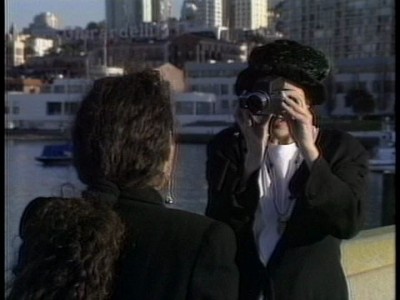
The first disc contains two long videos, 1993's Virtual Love and 1992's Seeing is Believing. Virtual Love is about a love triangle of sorts between two male virtual reality technicians, twins, and a young woman, enthralled with their technical expertise, who attempts to use the virtual-world disguises afforded by the media they're pioneering to seduce the twin she finds the most appealing. Seeing is Believing is a faux-documentary about a girl, her impoverished and reckless mother, and her wise grandmother; and the girl's attempts to negotiate the world around her through the possibilities of documentation with film equipment.
Disc two has four more videos: 1989's Longshot, 1990's Desire (Incorporated), a series of videos made between 1984 and 1996 and compiled as The Electronic Diaries, and a short from 2007, Life Squared. Longshot is another faux documentary, this time about the strained relationship between a young, appealing "at-risk" (intermittently homeless, drug-abusing, sometimes prostituting) woman and her relationship with a technophilic videographer/editor who becomes obsessed with her. Desire (Incorporated) is an actual documentary, in which Leeson and an actress discuss the process and consequences of an experiment Leeson conducted, in which she ran "seduction ads" featuring the actress on local cable stations and examined the multifarious, sometimes disturbing responses they elicited. The Electronic Diaries is Leeson's own self-reflexively autobiographical video confessions and musings. Finally, Life Squared introduces us to the new, virtual life of an art project Leeson created with Eleanor Coppola in 1972, before she began using video as her primary medium.
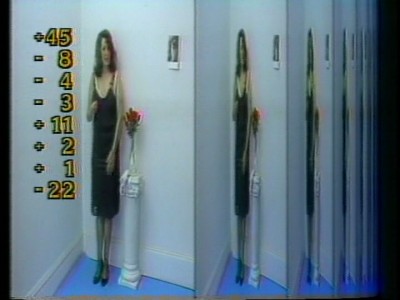
All of these works, with the exception of Life Squared (of which more later), have a common aesthetic: talking-head interviews (real or faux) are interspersed with dramatic footage conveying the story's "action," whether in present-time or flashback, and it is all edited together with wipes and other gimmicky, obtrusive montage tricks recognizable from early MTV. Visually, sonically, and at the level of performance and story, they resemble cable-access productions; the acting and the music, in particular, are inescapably broad, slapdash, and (in the case of the music) irredeemably cheesy. These videos are wearing their cheapness on their sleeves, to be sure, but what would presumably be the saving grace of something so self-consciously "amateurish"--the intellectual framework, the penetrating insight derived from understanding and exploiting the inbuilt paradoxes and contradictions of such an accessible, garishly rough and ready technology, the astute exploration of mediating, "virtual" technology as a cultural and social force--is also, for the most part, not there. The real problem with the work compiled here is not with its production values, but with the fact that the sensibility behind the productions is also in about the same league as a meandering, self-regarding, slightly paranoid cable-access program. (No unfair generalization is intended. I am certain that examples exist of cable access being used creatively, cleverly, and subversively; but it is not for nothing that it has a reputation as the conduit through which anyone can have a voice, yet in which no-one can manage to be articulate.)
Thus, running through these fictional video works, we have meandering, vaguely accusatory, not very revelatory or original ideas about technology, its complication of our lives, and its impact on our identities (Leeson, whether she appears in the videos or not, often interjects herself into the proceedings through voice-over narration and theorizing, which is long on bright wordplay and short on anything most thinking people have not observed before about the social effects of media and technology). These ideas are played out through self-confessed "crude and clumsy" narratives meant to illustrate and render vivid their ostensibly incisive ideas. It is not that Leeson has no visual sense; many still frames from these videos would in themselves make intriguing photos or installations. But when an artist's brilliant images move, speak, and have a soundtrack, those dimensions should be made to add something, to make the work stronger, and the visual interest in Leeson's work is sapped away by her failure or refusal to see that one has to make a motion picture--whether on video or celluloid, and whatever the budget or intellectual aims--move in one way or another, and preferably with some confidence and control when it comes to mundane but essential matters like blocking and guiding actors' performances.
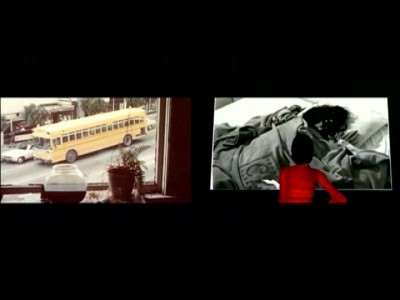
Unfortunately, instead of the desired effect of increased evocativeness and suggestiveness, Leeson's approach is simultaneously much too obvious and purposely, self-aggrandizingly obscurantist to call attention to much more than its own limitations, whether they are intentional/self-aware or not. I tend to be very open to the ethos and approach that Leeson wants to exemplify; her work could in some ways be seen as a forerunner to the early video work of Miranda July, whose efforts, however arch when compared to standard dramatic filmmaking, are much sharper and more fully developed than Leeson's. But when it comes to the actual execution of her ideas, with all the nuts-and-bolts planning, concentration, and precision that entails, Leeson reveals herself to be a sort of middlebrow, self-indulgent, Oprah-adherent "feminist" with a vague desire to Change the World and Make Important Observations While Challenging Us, but a very real and evidently more pressing need to discuss her own personal issues and feelings ad nauseum, to no discernible end other than her own catharsis in the act of confession. As a feminist, she is not of the critical, vitally intellectual lineage that includes Simone de Beauvoir and Germaine Greer (or, in the film world, Molly Haskell or Laura Mulvey). No, Leeson is much more of the mushy-minded, sentimentalizing, bourgeois, ultimately infantilizing Gloria Steinem mindset. This is especially apparent in The Electronic Diaries, which is almost unbearable to watch, not because of any real intimacy or useful discomfort involved in the experience, but because the portentous tone Leeson adopts to confess her sadly very common body image issues and past abuse undermines any real implication or engagement of us, the audience, in the experience. These are talk-show, Lifetime network, and "women's" magazine staples, which have been overexposed and made commonplace in all the worst, most trivializing ways. By keeping the focus on herself and her own experiences, rather than the widespread (perhaps even institutionalized) nature of these problems, Leeson fails to do anything to break that vicious cycle of sensationalization and banalization undergone by these very real, serious problems when they are discussed in public, on TV, and in artwork. That is exactly the tacky, exploitative cycle that Leeson's work apparently means to bring to our attention; but judging from these videos, Leeson's sensibility is itself mired too deep in the cycle it's trying to reject to offer any perspective, and the main beneficiary of, and ideal audience for, her blandly therapeutic work is the woman who created it.
Only Life Squared, a descriptive work encapsulating a larger project Leeson has worked on in another medium (virtual reality), really has much of an effect. Leeson's distorted voice-over narration and the virtual-world imagery give this short a nice sci-fi effect that actually does manage to use the visual and aural properties of video to evoke certain questions and feelings about technology and identity. This is by far the most recent work in the selection included on Seducing Time, and it appears that over time--but perhaps not quite in time--Leeson has come to the realization that honing your broad, vague inspirations and ideas with a certain concision and rigor is part and parcel of anyone's artistic process, no matter the medium or artistic goal.
THE DVD:
Leaving aside the question of whether or not it is an effective aesthetic strategy, the very lo-fi videotape look and feel of Leeson's work has been well preserved for this DVD edition.
Sound:Again, the sound of the original work has been preserved. It would go against the aims of Leeson's self-consciously videotaped aesthetic to have cleaned up the sound, so there is plenty of low-level buzz and vocal distortion throughout, but this is intentional; the work of bringing us the work as it was meant to be seen and heard has been done quite well.
Extras:None.
FINAL THOUGHTS:I am more than willing to grant that watching Lynn Hershman Leeson's work in a gallery or museum, surrounded by her work in other media (in addition to video, she has done installations, photography, and virtual-reality work), may provide a context in which the videos seem less self-indulgent and intellectually slack than they do when viewed on a home screen. Speaking strictly of this DVD compilation, however, all that can be said is that Leeson's work resembles the former Soviet Union: what must have looked like an eminently admirable plan in conception runs into absolutely terminal problems upon execution, and we are left to look elsewhere (to Matthew Barney or early Miranda July, to name just the tip of an intimidatingly large video-artist iceberg) for the video artist who can demonstrate the viability of tape as an art medium. Skip It.
|
| Popular Reviews |
| Sponsored Links |
|
|
| Sponsored Links |
|
|
| Release List | Reviews | Shop | Newsletter | Forum | DVD Giveaways | Blu-Ray | Advertise |
|
Copyright 2024 DVDTalk.com All Rights Reserved. Legal Info, Privacy Policy, Terms of Use,
Manage Preferences,
Your Privacy Choices | |||||||









